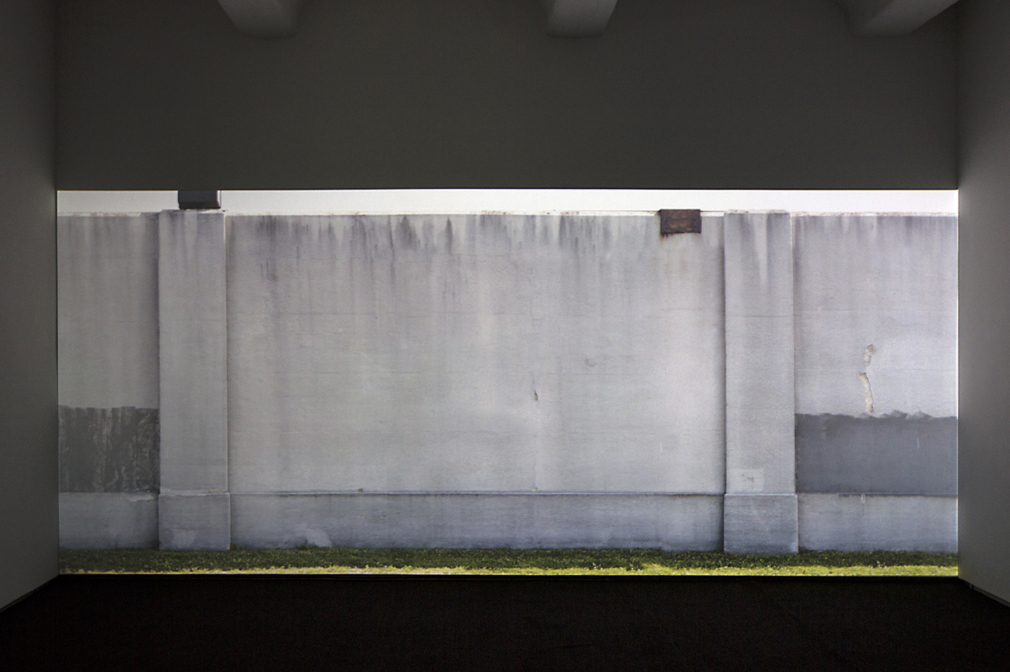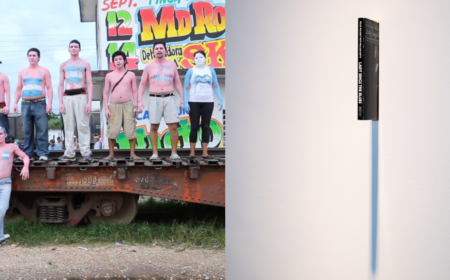Maria Gaspar (based in Chicago) often works on site-specific and community-based projects. For the last ten years, issues of mass incarceration and Cook County jail in Chicago, which is the largest single-site jail in the United States, have featured heavily in her art practice. In video, installations, and works in other media, Gaspar’s practice draws attention to the widespread impacts of carcerality in U.S. life, even as the workings of the nation’s prisons, jails, and detention centers often remain invisible for many.

2016
On the Border of What Is Formless and Monstrous
Courtesy of the artist
Five-channel sound and video installation Video: 14:52 minutes
The installation, On the Border of What Is Formless and Monstrous, combines sound recordings made from inside and outside the Cook County Jail with a slow video pan of the 25-foot jail wall which separates its inhabitants from the working class immigrant neighborhood in Chicago in which the jail is located. The seemingly endless expanse of gray cement is audibly punctuated by the joyful sounds of a carnival which takes place every summer on one side of the wall, and the institutional buzz and thuds of metal gates opening and closing along from the other. The work also includes an excerpt from a series of personal conversations and interviews with Adolfo Davis by his collaborator, Elyse Blennerhassett.
Convicted at the age of fourteen, Davis is currently serving a mandatory life sentence. In blending the sounds, the lines are blurred between the inside and outside of the largest single-site jail in the country. The sonic and visual experience of the work serves as a reminder of often overlooked, but almost overwhelming, scale and presence of incarceration in the United States, with 2.2 million people incarcerated in 1,833 state prisons, 110 federal prisons, 1,772 juvenile correctional facilities, 3,134 local jails, 218 immigration detention facilities, and 80 Indian Country jails, as well as in military prisons, civil commitment centers, state psychiatric hospitals, and prisons in the U.S. territories. In Gaspar’s words, “the carceral state is everywhere.”
On the Border Of What Is Formless And Monstrous (excerpt) from Maria Gaspar on Vimeo.
Maria Gaspar’s work and clips from her interview are also featured in the following Barring Freedom study guides: Carceral Visuality, From the Inside Out

Maria Gaspar’s projects have been supported by the Art for Justice Fund; the Robert Rauschenberg Artist as Activist Fellowship; the Creative Capital Award; the Joan Mitchell Emerging Artist Grant; and the Art Matters Foundation. Gaspar has received the Sor Juana Women of Achievement Award in Art and Activism from the National Museum of Mexican Art, and the Chamberlain Award for Social Practice from the Headlands Center for the Arts. She has lectured and exhibited extensively at venues including the Contemporary Arts Museum, Houston; the Museum of Contemporary Art, Chicago; the African American Museum, Philadelphia; and the Institute of Contemporary Art, Los Angeles. She is an assistant professor at the School of the Art Institute of Chicago, and holds an M.F.A. in studio arts from the University of Illinois at Chicago, and a B.F.A. from Pratt Institute in Brooklyn, NY.
Learn More
Suggested Reading
Anzaldúa, Gloria
Borderlands = La Frontera: The New Mestiza
First edition. San Francisco: Spinsters/Aunt Lute, 1987.
Browne, Simone
Dark Matters: On the Surveillance of Blackness
Durham: Duke University Press, 2015
Davis, Angela Y.
Are Prisons Obsolete?
New York: Seven Stories, 2003.
Freire, Paulo
Pedagogy of the Oppressed
30th anniversary ed. New York: Continuum, 2000.
Lorde, Audre
Sister Outsider: Essays and Speeches
Crossing Press, 2007.



